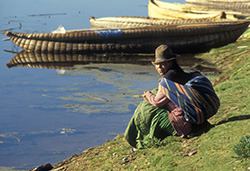Transboundary Waters

Worldwide, more than 263 watersheds and 300 aquifers cross the political boundaries of two or more countries and can be considered transboundary waters. International river basins cover 45.3 percent of the earth’s land surface, affect about 40 percent of the world’s population, and account for approximately 80 percent of global river flows. Populations in different countries are intrinsically linked by transboundary basins and aquifers, making them interdependent, not just hydrologically but also economically and socially, because transboundary waters are used for a range of livelihood activities.
The effective management of transboundary waters can produce benefits for people living in shared basins or using shared aquifers. Such basins and aquifers have certain characteristics that make their management especially difficult, however. For example, over-abstraction in a country upstream can lead to water shortages for both people and ecosystems downstream, and pollutants can be carried from one country to another, with potential impacts on livelihoods and health. Climate change further complicates such challenges because of changes in rainfall volume and variability and hence droughts and flooding.

Differences between countries in socio-economic development, water-use objectives, management capacity and political approach can make the effective management of transboundary waters even more challenging. If strategically managed, however, transboundary river basins can be a source of cooperation. There have been only 37 acute transboundary water disputes in the last 50 years, and 150 treaties have been signed. Nations value these agreements because they make international water-related relationships more stable and predictable. Nonetheless, 158 (60 percent) of the world’s 263 transboundary river basins still lack a framework for cooperative management.
Aquifers (underground water resources) are also shared internationally. Some of these contain huge freshwater resources – enough to provide safe, good-quality drinking water to meet the needs of all humanity for decades. Aquifers and their water quality are usually safer (i.e. pose less of a health risk) than other surface water sources, and governments – especially in water-scarcity countries – should take a strategic management approach to avoid depletion. The hidden nature of transboundary groundwater and a lack of institutional will and finance mean that the information needed for evaluating the potential of such resources and managing them sustainably is often lacking.

Despite the challenges, a range of useful tools is available for improving the management of transboundary water. Up-to-date information systems on water availability and demand can help increase the accuracy of models for determining the impacts of potential changes in the management and use of shared watersheds and aquifers. Independent institutions, such as river-basin organizations (e.g. for the Volta Basin and Nile Basin), can help enable regional cooperation in various economic and social areas, strengthen capacity (both in infrastructure and human resources) and offer technical support to member countries.
